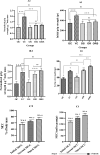Effect of resistance training plus enriched probiotic supplement on sestrin2, oxidative stress, and mitophagy markers in elderly male Wistar rats
- PMID: 38565633
- PMCID: PMC10987664
- DOI: 10.1038/s41598-024-58462-4
Effect of resistance training plus enriched probiotic supplement on sestrin2, oxidative stress, and mitophagy markers in elderly male Wistar rats
Abstract
This study aimed to determine the effects of resistance training combined with a probiotic supplement enriched with vitamin D and leucine on sestrin2, oxidative stress, antioxidant defense, and mitophagy markers in aged Wistar rats. Thirty-five male rats were randomly assigned to two age groups (old with 18-24 months of age and young with 8-12 weeks of age) and then divided into five groups, including (1) old control (OC: n = 5 + 2 for reserve in all groups), (2) young control (YC: n = 5), (3) old resistance training (OR: n = 5), (4) old resistance training plus supplement (ORS: n = 5), and old supplement group (OS: n = 5). Training groups performed ladder climbing resistance training 3 times per week for 8 weeks. Training intensity was inserted progressively, with values equal to 65, 75, and 85, determining rats' maximal carrying load capacity. Each animal made 5 to 8 climbs in each training session, and the time of each climb was between 12 and 15 s, although the time was not the subject of the evaluation, and the climbing pattern was different in the animals. Old resistance plus supplement and old supplement groups received 1 ml of supplement 5 times per week by oral gavage in addition to standard feeding, 1 to 2 h post training sessions. Forty-eight hours after the end of the training program, 3 ml of blood samples were taken, and all rats were then sacrificed to achieve muscle samples. After 8 weeks of training, total antioxidant capacity and superoxide dismutase activity levels increased in both interventions. A synergistic effect of supplement with resistance training was observed for total antioxidant capacity, superoxide dismutase, and PTEN-induced kinase 1. Sestrin 2 decreased in intervention groups. These results suggest that resistance training plus supplement can boost antioxidant defense and mitophagy while potentially decreasing muscle strength loss.
© 2024. The Author(s).
Conflict of interest statement
The authors declare no competing interests.
Figures





Similar articles
-
Endurance training and L-arginine intake: Their effect on antioxidant indices in the heart muscles of rats.Nutr Health. 2025 Jun;31(2):471-476. doi: 10.1177/02601060231187514. Epub 2023 Jul 18. Nutr Health. 2025. PMID: 37461355
-
Trans-resveratrol supplement lowers lipid peroxidation responses of exercise in male Wistar rats.Int J Vitam Nutr Res. 2021 Sep;91(5-6):507-512. doi: 10.1024/0300-9831/a000654. Epub 2020 May 13. Int J Vitam Nutr Res. 2021. PMID: 32400317
-
Myocardial antioxidant status and oxidative stress after combined action of exercise training and ethanol in two different age groups of male albino rats.Acta Biol Hung. 2007 Jun;58(2):173-85. doi: 10.1556/ABiol.58.2007.2.4. Acta Biol Hung. 2007. PMID: 17585507
-
Swimming exercise and nano-l-arginine supplementation improve oxidative capacity and some autophagy-related genes in the soleus muscle of aging rats.Gene. 2023 Jan 20;850:146955. doi: 10.1016/j.gene.2022.146955. Epub 2022 Oct 8. Gene. 2023. PMID: 36220447
-
Effects of increased dietary fat and exercise on skeletal muscle lipid peroxidation and antioxidant capacity in male rats.Eur J Nutr. 2005 Oct;44(7):429-35. doi: 10.1007/s00394-005-0548-9. Epub 2005 Jan 7. Eur J Nutr. 2005. PMID: 15633018
Cited by
-
Neuroinflammation increases in old and oldest-old rats except for dura mater meningeal tissue with significant gender differences: a translational perspective.Biogerontology. 2025 Mar 14;26(2):73. doi: 10.1007/s10522-025-10212-3. Biogerontology. 2025. PMID: 40085280
References
-
- Sobhon P, Savedvanich G, Weerakiet S. Oxidative stress and inflammation: The root causes of aging. Explor. Med. 2023;4:127–156.
MeSH terms
Substances
LinkOut - more resources
Full Text Sources
Research Materials

